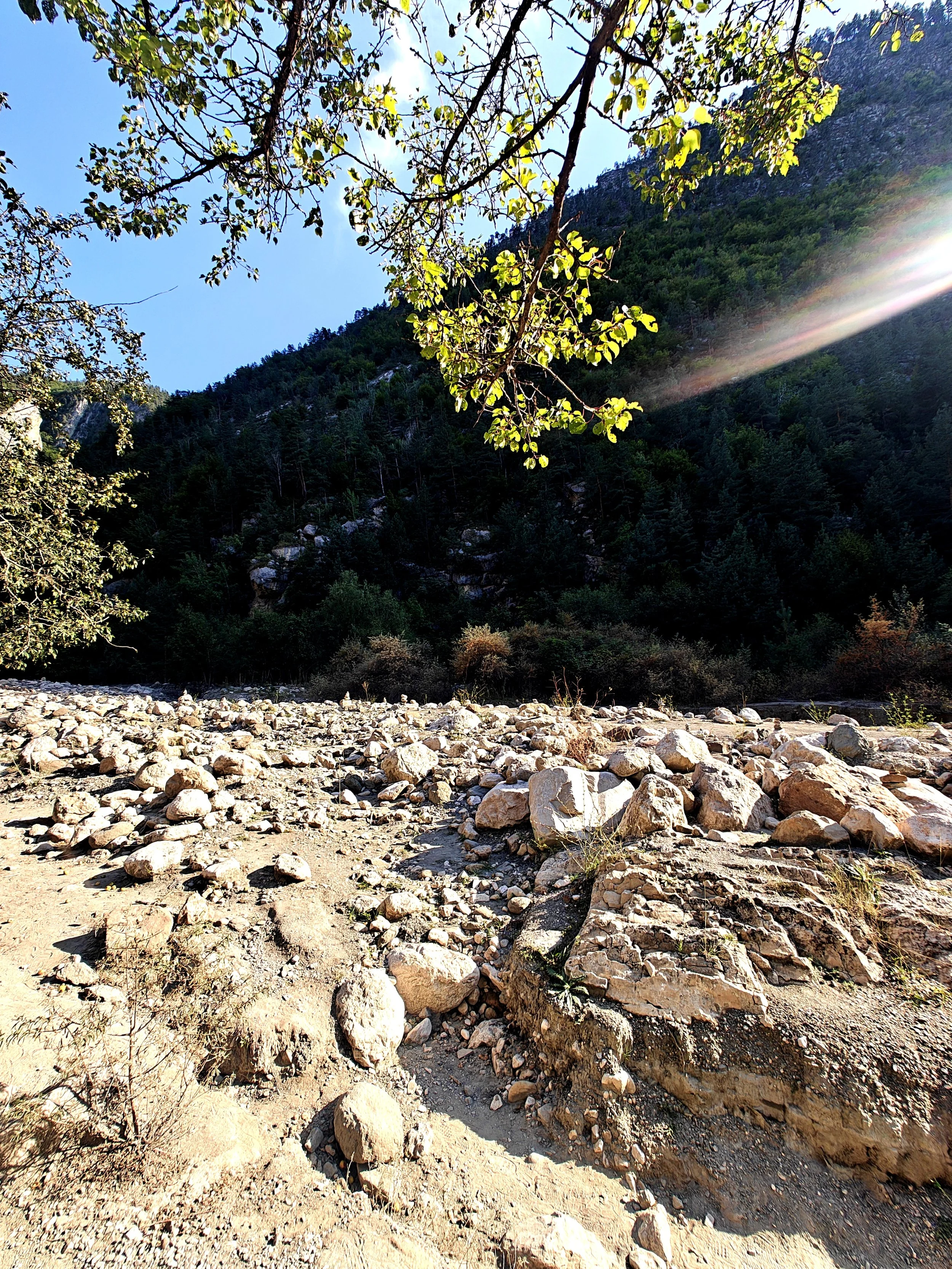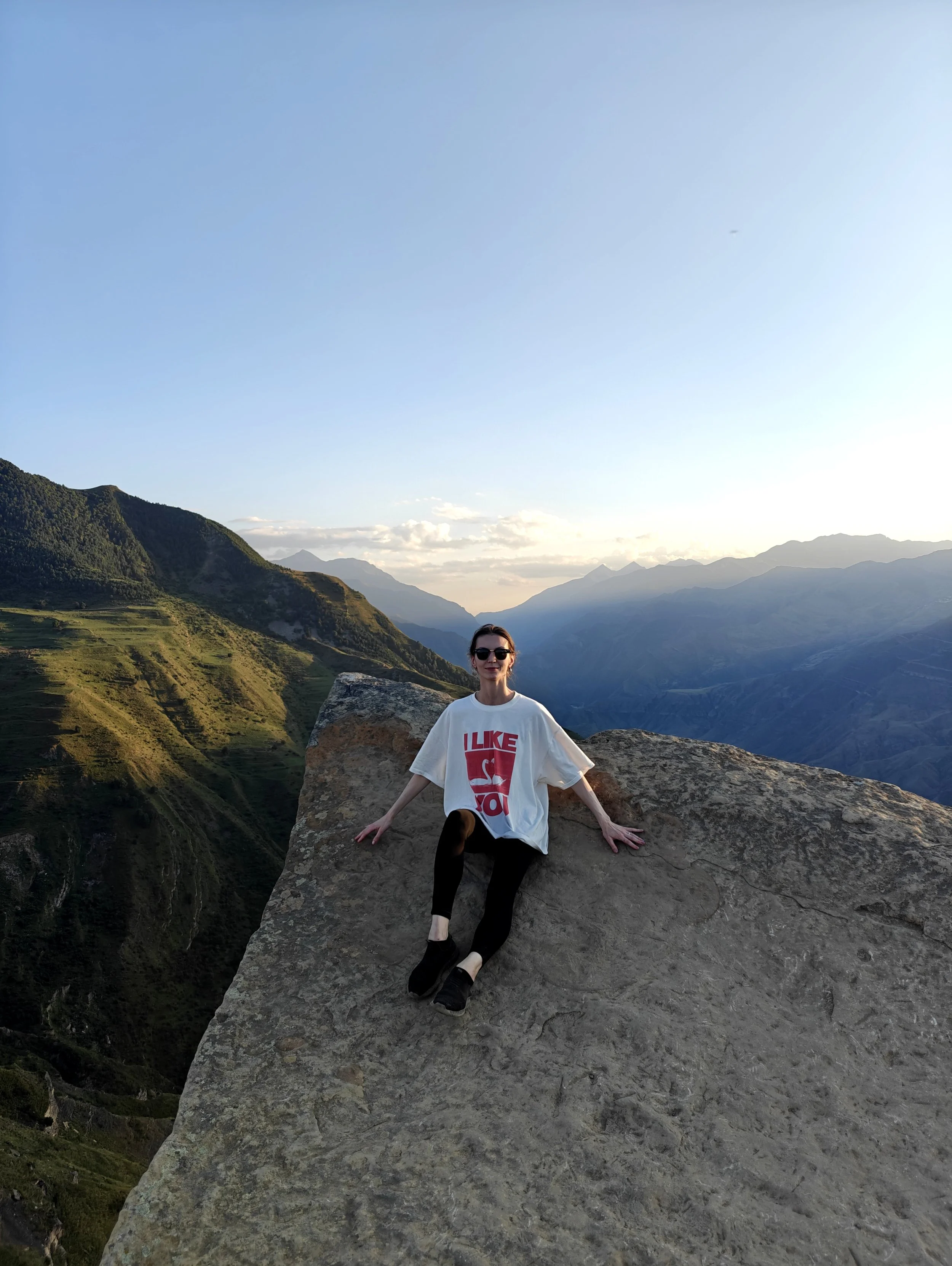Dagestan 2-0
With enthusiastic eyes, we flied back to Dagestan, but this time, knowing the country, we didn't stop in the capital Makhachkala (the “Moscow” of Dagestan) and immediately drove to their beautiful mountains. Then we spent a few days at the Caspian Sea (Derbent City), where by the way, you can swim until November or even December !
In this post, I want to share about the unknown beauty of this mainly Muslim region of Russia and everything you would never know until you go there and speak with locals.
You will be surprised.
Let’s travel now !
If you want to know the most beautiful places in Dagestan, a must-see, and the two best tour schedules, then check out my previous post on the link below!
Very old civilization
A stone with a petroglyph was found by local historians in the Kulinsky district of Dagestan. The solar sign is a symbol of infinity and light.
Residents of the village of Kuli are sure that they have also found six ancient pyramids, creating a ziggurat - a cult structure of an ancient civilization.
All of these discoveries seems to be from
the Cimmerian people, one of the most ancient people (1000 years BC) of Eastern Europe and still a mystery for historians and archaeologists.
A few months ago, I remember walking into the Pushkin State Museum in Moscow and admiring the rich heritage of the Cimmerian Empire. I was fascinated, not only by the quantity of writings, but also by the refinement of objects and sculptures full of mythological creatures.
Historians have still not come to a consensus on the origin of these ancient people.
In the Odyssey, Homer tells of the country of the Cimmerians, which stretches along the ocean shore. During the polar night, Odysseus sailed to this country and visited one of its cities. Odysseus describes it in the darkness, without a ray of sunlight.
They had a reputation for being fearsome warriors.
In the same region of the village of Kuli (the highest village in altitude of Dagestan) was found a burial of six people sitting around a pot of "fire", which is assimilated to the fire worship animist religious ritual.
Dagestan was also the kingdom of a powerful dynasty, The Kura-Kazikumukh Khanate. This feudal state existed on the territory of Dagestan from the end of the 16th century until the end of the 19th century. Prince Alibek was considered the founder of this kingdom, and it was at the beginning an alliance between villages to resist and protect attacks by enemies. They had a powerful army of men, and their last resistance was against the expansion and domination of the Russian Empire for 40 years, known as the Cossack War.
This legacy of strong men and warriors was passed down to the men of Dagestan. The national sport is now wrestling. All the men know how to fight and shoot.
We also visited a small Christian church dating from the 8th century.
There are everywhere ruins of villages, the most famous being Gamsutl, called the ‘Machu Picchu of Dagestan’.
Located at an altitude of almost 1,500 meters in the North Caucasus, it used to be an Avar village, carved out of rock, and it is considered to be 2,000 years old. Villages used to be built at the highest point, accessible by a single, narrow path, so they were easy to defend.
Our trip ended in Derbent, a beautiful coastal city with a fortress dating back 5000 years. 5000 years ? I still can't believe it. The government wanted to officialize it for 2000 years, after the birth of Jesus Christ, but they fortunately showed proof of the true age of this city.
This detail on history made me meditate on everything I learned in school : obviously, we know nothing about what happened before the birth of Jesus Christ, but civilization already prospered long, long time before...
Diversity of ethnicity and religions
With over 30 ethnic groups and 81 nationalities, Dagestan is one of the most linguistically and ethnically diverse regions in Russia.
Each of the ethnic communities has its own unique language, culture, and traditions and usually lives in separate villages.
Conventionally, all Dagestanis can be divided into 3 large groups:
1. Representatives of the Nakh-Dagestan mountain peoples: Avars, Dargins, Laks, Lezgins, Tabasarans, Rutuls, Chechens-Akkins, etc.
2. Turks: Kumyks, Azerbaijanis, and Nogais.
3. Indo-Europeans: Russians, Armenians, Tats (including Mountain Jews).
The main language taught in school is Russian, nevertheless there are 14 dialects considered official state languages in Dagestan.
Depending on these ethnicities, most believers are Muslims (mainly Sunnis, as well as Shiites), Mountain Jews profess Judaism, and Russians - Orthodox Christianity.
I can't help but be surprised by the peaceful cohabitation of these people with such different beliefs.
When talking to the locals, we came to the conclusion that this was due to a great respect for traditions, for the oldest, and for their roots. You can't do something bad, otherwise you will be ashamed in front of "Allah" and you will also betray and dirt your ancestors (and family).
It's a powerful and unique vision of society based on traditions.
Tourists are welcomed very warmly, but they will appreciate if you respect their traditions. Among them :
Not hugging and kissing in public; it's considered sexual practice; you do it only in private.
Holding hands is still okay, but preferably not.
The body should not be visible; forget about shorts, and women should wear clothes that cover their bodies; you don't have to cover your hairs but keep them attached.
This is the case in the Muslim community, which represents 96% of Dagestan Religion. For example, a couple has been refused a seat in a restaurant because the woman was in shorts. Of course, you can not respect these traditions, knowing you are tourists, but it will be seen as disrespect.
Near the Nature
I think you can understand how a culture lives close to nature by what they eat, drink, cultivate and the way they live.
Dagestan is one of these places where you will finally eat food that tastes incredible (eating a simple tomato is enough to understand why). Quality is more important than quantity. I eat meat there, I have long time didn't taste. Actually, in the city, I rarely want to eat meat, but in Dagestan, even vegetarians can't resist the taste of meat (it's from a true anecdote !).
All products are local and self-made (bread, cream, cheese, etc.)
There are so many herbal teas of all kinds... Since they live in mountains, people always used to harvest herbs and flowers to make tea. Daily herbal tea is their medicine.
They also make, of course, their own jam (apricots, berries, and figs). There are many valleys of fruit trees, which are the vestiges of the flourishing USSR collective farms (Колхоз).
It's also important to note how clean the water and air are in the mountains. You can stop in a 2000-altitude village for a few days at least, everyone knows the benefits of altitude and clean air on the general state.
Dagestan would not be Dagestan without its kitchen.
Please discover here a few meals you must try on your next visit !
Khinkal (Хинкал) is a symbol of the Dagestan kitchen, born in the mountains, that consists of broth, boules dough and meat (mainly lamb or beef). There are several types of them, depending on the region. The main difference is in the shape of the dough pieces : thick diamonds or rectangles (Avar), sausages or "ears" (Lak), rolls cut into circles (Dargin) and thin rolls (Lezgin).
Chuck (Чуду) are delicious traditional Dagestan pies, made with a variety of fillings - potatoes, meat, tripe, cottage cheese, pumpkin, cheese, and greens. There are two kinds of them : thin flatbreads and thick ones (Dargin).
Shashlik (Шашлык) The meat for shashlik is marinated with greens and lots of onions. It is almost impossible to buy bad shashlik in Dagestan, meat being the main product in the republic, it is treated with love. Veal, beef and chicken meat with the main spice (nut grass) are delicious.
Kurze (Курзе) This dish is most similar to Russian pelmeni, meat dumplings served with white sour cream sauce. They can also be filled with potatoes, eggs and cheese, incorporating a lot of spices and herbs.
Urbech (Урбеч) is a paste made from ground nuts, seeds or kernels. It is filling and high in calories, which was especially important for shepherds in the mountains. It's considered a super food, and locals also eat it as medicine. You can eat it plain, spread it on bread, or use it as a sweet with tea. I tried flax seed Urbech on the Apricot porridge, and it was so yummy.
Apricot porridge (Абрикосовая каша) There are many apricot trees in Dagestan, so their fruits are often used in various recipes, one of them is porridge. It is prepared with apricot and flour, to which you usually add urbech, honey, or butter.
Dagestan tea : This is a tea made from high-mountain herbs - thyme, mint, lemon balm, sage, chamomile and many others—in which they also add berries and leaves. The taste is multifaceted, delicious, and I won't describe the multiple benefits of drinking it.
I wish you a wonderful trip to Dagestan, and keep me posted !
I am sure that you will be like me, amazed by the beauty of the landscapes, the delicacies of the cuisine, and the kindness of its inhabitants.
If you know where to rest in Dagestan, then you can rest like nowhere else. The best is to have a private local guide drive you all around the country.
I recommend you spend at least five or six days.
I share with you my special contact (that someone from there at one point shared with me), and you will not only see touristic places but also taste the culture and traditions. The best is to contact him in WhatsApp.





























